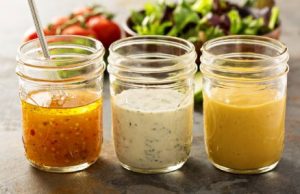
Kuigi konkreetse mandri köögi põhitõdesid on äärmiselt raske kirjeldada, on teatud tegureid, mis suudavad hõlmata peaaegu iga riigi rahvuslikke toidutraditsioone. The first word that strikes the mind when one thinks of the Asia is – healthy. Jaapanit on laialdaselt tunnustatud riigina, kus inimestel on pikim eluiga. Ülejäänud maailm hakkab alles nüüd rohkem tähelepanu pöörama Aasia väljakujunenud toidutavadele ja rakendama neid oma igapäevastes toiduvalmistamise retseptides. Vaatame erinevate kastmete ja maitseainete rolli Aasia köögis.
There are two defining factors in the typical Asian cuisine – love of fish and sea food, ning erinevate vürtside ja maitseainete laialdasem kasutamine. Pole haruldane, et sellel mandril on toidukorral kuus või enam erinevat maitset. Kõige populaarsemad on soolased, soolane, magus, vürtsikas, hapu, kibe, kokkutõmbav (selline, mis kutsub esile tõmblemise tunde), and let’s not forget about the specific Japanese umami – a brothy (või lihane) maitse, mis püsib kaua.
Korealastel on ka oma ainulaadne kimchi maitse. Vürts ise on valmistatud kuivatatud ja jahvatatud köögiviljadest ning on äärmiselt kuum, nii et ärge olge seda toidule pannes liiga helde. India traditsioonilisele toidule meeldib sisaldada palju ingverit, küüslauk, safran, ja garam masala nende tüüpilistesse roogadesse, samas kui hiinlased on kurikuulsad Sichuani piirkonnast pärit punase tšilliõli kasutamise poolest.
Asi, mis neid kõiki ühendab, on armastus detailide vastu, distsipliini, samuti harmoonia ja tasakaalu saavutamiseks. See on ka täielikult kooskõlas nende väljakujunenud usutavadega. Isegi kui eine võib sisaldada rohkem kui 10 eraldi koostisosad, see jääb ikka suusoojaks ja maitsev.
See maitsete ja maitsete mitmekesisus on tingitud asjaolust, et Aasia riikide territoorium on laienenud ning neid eraldavad suured mere- ja maismaapikkused.. Mõningaid vürtse leidub looduslikult mõnes mandri piirkonnas, while others – in more distant ones.
Halvad toitumisharjumused Et Sa peaksid unustama
Kuidas sidemeid kasutada & Maitseained Aasia köögis
Tasakaal söögi valmistamisel
 Aasialased on üsna organiseeritud inimesed. See nende omadus on üsna silmapaistev ja nad on selle eest hästi austatud. Peamine erinevus läänemaailma inimeste ja nende vahel seisneb selles, et meie rahvuslikud traditsioonid jagavad tooted erinevatesse toidugruppidesse juba valmistamisprotsessist alates..
Aasialased on üsna organiseeritud inimesed. See nende omadus on üsna silmapaistev ja nad on selle eest hästi austatud. Peamine erinevus läänemaailma inimeste ja nende vahel seisneb selles, et meie rahvuslikud traditsioonid jagavad tooted erinevatesse toidugruppidesse juba valmistamisprotsessist alates..
Sama teeme ka eine serveerimisel. Aasia köök viib asjad täiesti uuele tasemele ja lisab mitte ainult segu erinevatest vürtsidest, maitsetaimed, ja koostisained, aga ka palju erinevaid tekstuure, mis suudavad suurepäraselt kokku sulanduda.
Tasakaal ja täpsus on tegelikult Aasia köögi peamised koostisosad. Palju tähelepanu pööratakse ka sellele, kas sööki serveeritakse külmalt, kuum, kuiv, niiske, raske või kerge. Seda tehakse selleks, et tagada korralik seedimine pärast toidu söömist.
Ka lihatooteid ei kasutata nii laialdaselt. Riis ja köögiviljad, teiselt poolt, on peamised komponendid. Sama kehtib ka kastmete ja maitseainete kohta. Aasias, tavaline on seesamiõli lisamine, kalakaste, tsitrusviljade mahl, või sojakastet salatikastmetesse.
Maitsestamine & Kastmed Aasia köögis
 Teine traditsioonilise Aasia köögi määrav hetk on nende armastus erinevate vürtside ja ürtide vastu. Maitseaineid ja kastmeid kasutatakse laialdaselt ka selleks, et mitte ainult toidu maitset parandada, vaid ka hõlbustada kehal eraldi komponentide lagunemist ja vältida tüütuid kõhuvalusid ega hädasid..
Teine traditsioonilise Aasia köögi määrav hetk on nende armastus erinevate vürtside ja ürtide vastu. Maitseaineid ja kastmeid kasutatakse laialdaselt ka selleks, et mitte ainult toidu maitset parandada, vaid ka hõlbustada kehal eraldi komponentide lagunemist ja vältida tüütuid kõhuvalusid ega hädasid..
Neil on eriline kiindumus maitseainete vastu. Öeldud võivad olla sambalid, tšatnid, ja dals. Veel üks tüüpiline omadus on see, et pole harvad juhud, kui need on valmistatud tšillipiprikast, kala, tamarind, küüslauk või mõni muu lehtvürts.
Enamik maitseaineid ja kastmeid võivad olla üsna kuumad. Tuntumad on kalakaste, seesamiõli, ma olen paju, Sriracha, tšilli küüslaugukaste, ja sambal trassi.
Kuna enamikku erinevatest vürtsisegudest ei kasvatata ühes ja samas piirkonnas, peale karri, mandri eraldiseisvatel osadel on oma unikaalsed stiilid.
Lai valik vürtsisegusid
Eastern Asia is infamous for its regular use of these spice blends – Japanese Seven Spice, Teriyaki segu, Hoisini kastme segu, Kääritatud ubade maitseained, samas kui Lõuna-Aasia keskendub rohkem neile, mis sisaldavad karrit. Samuti meeldib neile lisada toidule mitu kihti, mis tähendab, et seda kombineeritakse sageli kookospähkli puuviljade või õliga.
Aasia kaguosa külastus tähendab, et kaste ja maitseained on äärmiselt kuumad ja vürtsikad. Tavaliselt on neil tugev lõhn, mis muudab toidud täiuslikuks seguks vürtsika ja magusa vahel.
Aasia kastmed & Seasonings – Hot but Delicious
 Kõigile ei meeldi vürtsikas toit. Kuid üks asi, mis muudab kuumade kastmete või kastmetega maitsestatud toidud nii tervislikuks, on asjaolu, et sellel on võime tappa baktereid ja kaitsta parasiitnakkuste eest..
Kõigile ei meeldi vürtsikas toit. Kuid üks asi, mis muudab kuumade kastmete või kastmetega maitsestatud toidud nii tervislikuks, on asjaolu, et sellel on võime tappa baktereid ja kaitsta parasiitnakkuste eest..
Aasia köök ja selle eripärad ei sobi iga inimese maitsele, kuid see on kindlasti proovimist väärt.


